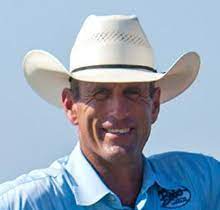 Total Earnings: $624,535
Total Earnings: $624,535
Three time World’s Greatest Horseman, Russell Dilday, got his start in the cow horse world after watching the 1993 Snaffle Bit Futurity in Fresno when Sandy Collier won. His father-in-law was also a cow horse trainer.
Dilday had grown up around horses. His family ranched and roped for fun. Dilday’s dad and uncle showed him how to train rope horses. Dilday’s family was also good friends with Greg Ward and they all roped together. Eventually Dilday went to Ward to learn about cow horses.
Cow horses became a full time business for Dilday, leading to multiple major championships including 2008, 2009, and 2011 World’s Greatest Horseman.
Today, Dilday ropes on all his horses as part of his training program.
What is your training philosophy?
“I want the horses to be featherlight at the fastest speed they can run. Getting them to do that you have to have them confident slow. And then you have to go out there fast and make them confident there without [being hard on them]. You can’t go real fast, get them spooked and you be hard on them for being spooked. That just doesn’t work very well. And even [if] you’re in a wreck you’ve got to stay calm and get them to relax, come back to you and go do it again.”
What has been your most memorable moment in the sport?
“One of my most memorable moments was the first saddle I won in Reno on San Jo Lena…It turns out that my cousin had been contracted to make the saddle.”
What is your advice for up and coming trainers?
“You need to seek a lot of help but you have to think your way through your problems. If you rely on your help only to fix your problems, you won’t know how you got to a better place and you’ll go right back to the bad place [doing] whatever you had wrong as soon as that one piece of advice wears out. Because nothing lasts forever. No fix is forever. You have to really slow down and think through even when someone gives you advice you have to break it down and understand what they are trying to get you to do with the horse.”
“If you want help, be helpful.”
What has been your inspiration over the 30 years you have been in the sport?
“When I was young, horses were just our life. When I started getting around Greg, I thought I could put a horse anywhere I needed to, when I got around Greg I saw a whole other level. Especially being able to get them comfortable and doing everything with their head so low and soft. That was amazing to me. And doing the fence work with the speed. As much as I like roping, I thought the fence work was just sheer joy.”
When a horse has their head low, what does that communicate to you as a trainer?
“If their head is low because they are relaxed and their hind quarters are under them, to me that communicates that they are relaxed and balanced. If their head is low because you were pulling on their mouth and made it low, they generally have their chin on their chest and then they are not balanced. They’ve got too much weight on their front end and it’s not as enjoyable. When I say low, I like that head to be out on the end of that horse’s neck and just floating there wherever is comfortable. And the further that hind leg comes under him, the lower [the head] will be two-thirds of the horse’s weight should be on its hind end and one-third on the front.”
How do you define feel?
“Feel is just knowing when the slack comes out of the reins, it’s knowing what the horse is doing just when the slack comes out. People without much athletic ability can learn feel. It’s harder but they generally have a better concept of the whole picture when they get it figured out. People that are naturally gifted and they have feel on them, they don’t always have all of the mechanics broke down in their mind because they just see it and do it. If you don’t know what happens when the slack comes out of the reins, you probably went past the feel and straight to the pull. That is human nature and that is what we fight all the time…”
